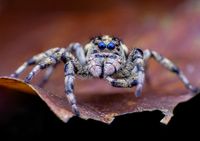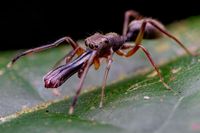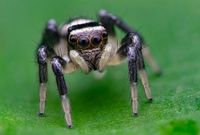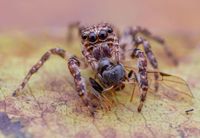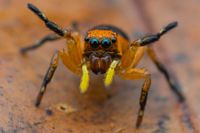Welcome to the cosmos of jumping spiders
Spiders? Jumping spiders to be precise. Please try to overcome your Arachnophobia and follow me on my journey into the fascinating world of jumping spiders. Maybe I will be able to infect you a little with my passion for these fascinating creatures.
These little wonders of evolution come in an unbelievable variety of over 5'500 species, and maybe many hundreds more waiting to be yet discovered. A true paradise for the macro photographer and scientist. Following some interesting facts about jumping spiders:
What are Jumping spiders?
Jumping spiders are very small, from 2 mm - 22 mm in size, and absolutely harmless for humans. With their tiny fangs most species are not able to penetrate human skin. Larger species like Phidippus rarely bite and can break the skin, but other than a little pain no lasting damage will occur.
With their over 5’000 described species jumping spiders (Salticidae) make the largest family of spiders in the order of Araneae.
Jumping spiders don't spin a web, they use their silk for cocoons to sleep in, protect their eggs and, in colder areas, to overwinter. Most species also use a silky safety line when jumping.
Their name jumping spider refers to their method of making prey. They stalk or hunt their victims and when close enough jump onto them and kill them by injecting fast acting poison with their fangs.
Main characteristics for this spider family are the two frontal pair of eyes "oOOo", the mostly squad body shape and the short, strong legs.
The sense of vision
Jumping spiders have probably the best sense of vision among arthropods, what is essential for hunting, navigation and courtship. With their characteristic oversized principal eyes they can detect even smallest details. The three secondary pairs of eyes are sensitive for motion and brightness and give the jumping spider almost a 360° field of view.
To estimate the distance to the potential prey, jumping spiders are truly masters of calculation. Not only the distance has to be judged correctly, obstacles or wind come also in the equation.
The principle eyes are built like a telescopic tube with a multi-layered retina and an adjustable lens at it's bottom. The different retina layers are sensitive to different wavelengths of light, but only the deepest receives a sharp focused picture. The layer above will receive an "out of focus" picture. By measuring the amount of fuzziness it's possible to calculate the distance to the object in front of them. Amazing if you consider that their head usually is smaller than the head of a pin.
The jump
Jumping spiders don't have large muscles for jumping like grasshoppers. Instead they have a well developed hydraulic system. By altering the pressure of the body fluid (hemolymph) and releasing this pressure to extend their limbs, the jump is initiated.
The limbs stretch within a few 1/1000 of a second and catapult the spider forwards. The amount of pressure controls the length of the jump. Most jumping spiders can jump several times the length of their bodies.
Before jumping the spider fixes a silky dragline to the ground. If it misses the target or it gets away, the spider can climb back to the point of origin on this safety line. It is suspected that the spider also stabilizes the position of it's body during the jump with this dragline to ensure a precise landing onto the prey.
Making prey
Once jumping distance is reached and the dragline secured the spider jumps onto the potential prey. As soon as contact is made the jumping spider grabs the victim with its front legs and administers a bite to inject rapidly acting poison that immobilizes it immediately, giving the prey almost no time to react. This explains why the pray can be much larger and stronger than the spider itself.
Different species of jumping spiders hunt for different prey. Some are specialized to feed almost only on Mosquitos with a preference on those who recently sucked blood. Others steal the prey out of spiderwebs and, if not careful enough, the owner of the web as well. Even other species of jumping spiders can become the prey of a jumping spider.
Growth
As with all Arthropods, the body of jumping spiders is covered and protected by an exoskeleton. Normal growth therefor is almost impossible. They need to mold to grow bigger.
Once the old suit is getting to tight, the shield of the behind body unfolds and the spider is rising the pressure of the body fluid (hemolymph) to pump up its front body until the body shield breaks open. Afterwards the behind body is freed and the legs are being pulled out of their shield under powerful exertion. The whole process takes several minutes to complete.
The now fresh spider does some gymnastics to keep the joints flexibel during hardening of the new tuxedo. This whole process is repeated five times until maturity is reached. The intervals between molding are very short in the nymph state and are getting longer with age, depending on the food supply.
